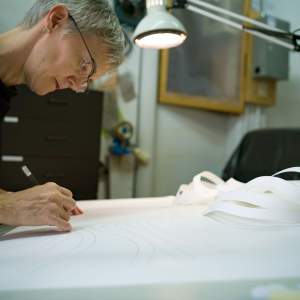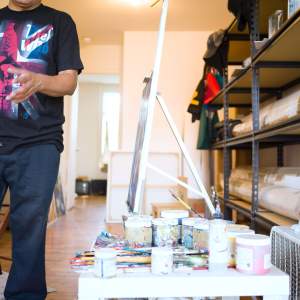Qiana Mestrich is an artist, educator, and writer who consults with Joan Mitchell Foundation grant recipients as part of our ongoing Professional Development series. We asked Qiana to share her tips on organizing a critique group for regular critical feedback on your work.
Are you a recent graduate who misses getting constant feedback from your creative peers and/or faculty members? Are you in the midst of a body of work and need constructive criticism? Once you’ve left the nurturing confines of art school, artists often find they are working in isolation and no longer have access to a creative community. It can be hard to get opinions on your work other than generic and/or biased comments from your life partners and/or family members. This is especially true if you’re working from a studio in your home.
So what do you do? Start your own group critiques! It sounds a lot more intimidating than it is, but with the proper planning and guidelines to ensure that critiques are productive, you can create a unique and supportive community. Read on for tips on how to start an art critique group that meets regularly, plus insights into how your work and your career can benefit from regular critical feedback.
Find a Host/Space
First and foremost you need a space to meet and preferably one that is available on a regular basis. A central meeting place serves as the foundation or “home” of your critique group and will avoid confusion over where the monthly crits will be held. Ideally the space will have lots of natural light or track lighting to illuminate the artwork. White walls also help if artists are showing two-dimensional pieces or prints.
Once you have a space, don’t forget to provide chairs for people to sit on and materials for artists to install/show their work including artist’s tape, T-pins or thumbtacks, and tables or pedestals for sculptural work. Some artists might want to show digital images or project their work on a screen so it’s useful to have access to a computer with a large monitor or one that works with a projector.
If you can’t find a central location that is always available, try rotating spaces and having artists take turns in hosting a critique session in their studio space or home. Another option is to ask a gallery or community/arts organization if they could host a critique space; see for example Red Hook Labs in NYC.
Establish Regular Schedule + Time Organization
Determine how often will you meet: monthly, bi-monthly, or quarterly? Unless you have a large group of 10 or more active participants, anything more often than monthly likely won’t work as artists need time to create.
For each session, you’ll also need to determine how long the critique will last, how many artists will be critiqued in this session, and how much time will be given to each artist. I’d recommend no more than 3 hours total for one crit session and within that you could allot 45 minutes to an hour per person. The rest of the time can go towards other activities like set up/break down of work, bathroom or food breaks and general “catching up” conversations that tends to happen amongst attendees.
Communication is key to keeping the critique group going, so after the first session, find the best way to let everyone know when future sessions will happen. That could mean setting up an email list, a Facebook Group page, sending a group text message via mobile, or even just planning future dates right at the end of your session before everyone leaves.
To keep track of who’s showing work when, consider using a shared doc in Google Drive where artists can sign up for a specific date. Having some mode of regular communication with the group helps to keep everyone connected and is also great for sending meeting reminders and planning other events like outings to art exhibitions for those times when no one has work to show.
Decide Your Critique Style & Establish Guidelines
Will someone moderate the discussion? Should everyone be required to speak? How will you handle rude, hateful, or unhelpful comments? Should artists introduce their work first or should attendees just offer their opinions without context? What happens if no one talks? These are all questions that you’ll need to address when deciding the format of your critique group. Some of them you can decide on right away, while others will take time to develop.
The group’s host or founder can decide to moderate the discussion, but should avoid doing so all the time as hierarchy issues might arise. You can avoid this by creating a rotating schedule that lets others moderate, or not choosing to have a moderator at all, although someone should always be keeping track of time.
Make sure to communicate that critiques are not intended to be a debate session. Respect for one another is mandatory and abusive behavior will not be tolerated. The goal is always to critique the work, not the artist. Participants should be expected to ask positive questions, listen without interrupting, and keep an open mind without getting defensive by taking what is said not as “criticism” but as specific suggestions for improvement.
Invite Artists & Other Guests
How many people do you want in your group? You may already have a group of artists that you can organize around but if you don’t, consider reaching out to your fellow students/alumni from art school. Or seek out artists in your area by posting signs for your critique group in cafes and bookstores, or putting out a call on social media.
If your group is made up entirely of painters, do you want to invite artists that work in other mediums to get varied opinions? Or if you wanted more diverse points of view in your critiques, you could consider inviting other art professionals like curators, gallerists, art historians, educators, or arts writers/journalists. Avoid having uninvited guests who may not have any art experience at all as their presence may make others uncomfortable and thus set a weird tone for the critique.
Getting Started
Even if your group of artist peers is small (perhaps just yourself and one other artist), you can still host productive critiques. If you find yourself in complete isolation with no other artists around you, as long as you have an internet connection you could consider hosting critiques online with artists from anywhere in the world using group video chat/conferencing software like Google Hangout or Skype.
When hosting (your first) critique, be sure to tell artists who are showing work that day to arrive 20-30 minutes early to install their work. If you’d like or are able, you can offer drinks or snacks but avoid serving alcohol, unless you’re comfortable doing so. Drinking might turn the session into more of a party atmosphere than a productive critique session. If you’ve invited an arts professional as a guest speaker or moderator, pool your resources and offer to pay them for their time.
For those moments of awkward silence, consider having books, magazines, and/or other reference materials on hand that you can turn to when talking about a particular period in art history, a particular technique, or medium. Having a computer with internet access or using your mobile phone can also help to look up artists who make similar work.
For more direction on how to critique art, consider watching this YouTube video or check out this blog post, which has some useful links.
How Critiques Benefit Artists
Besides creating a community, regular critiques can be useful to your art practice. Critiques help artists develop crucial public speaking skills and also help them understand how/what their work is communicating to others. Other benefits include getting tips on creative techniques, materials, and other resources you may not be aware of. Through conversation with your peers, you may also learn about exhibition and grant opportunities that may help get your work more exposure.
Lastly, meeting with other artists regularly just inspires you to make work regularly. So if you’re in a creative rut or just need/want to be around like-minded makers, don’t hesitate to start your own critique group!





